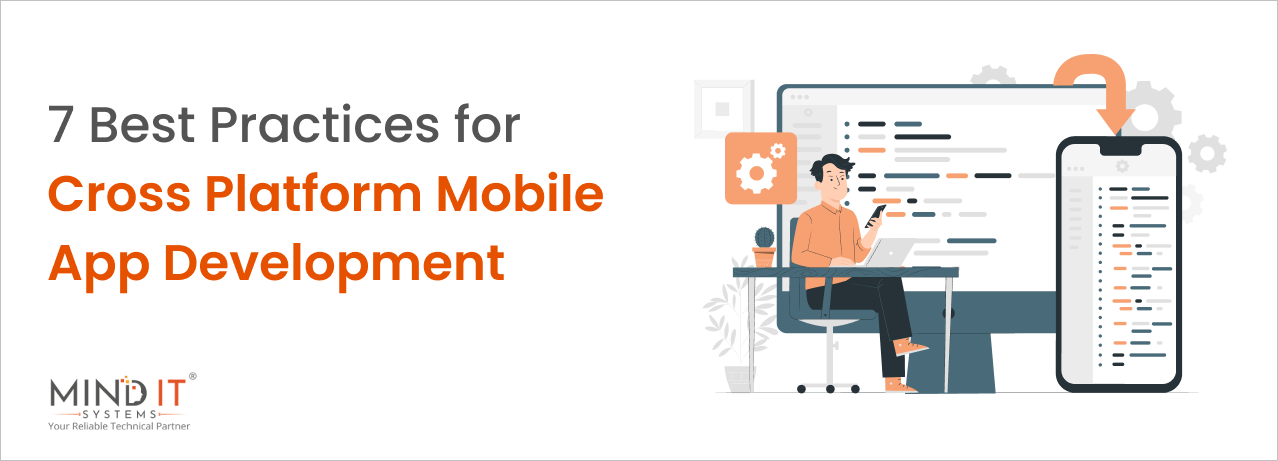
7 Best Practices for Cross Platform Mobile App Development
Introduction
With mobile technology advancing at lightning speed, businesses need solutions that keep them ahead of the curve. Cross platform mobile app development is transforming how companies create apps by enabling one codebase to serve multiple platforms like iOS and Android. This approach saves time and resources and ensures a broader audience reach. In this blog, we’ll guide you through the best practices for making your cross-platform app stand out in today’s crowded market.
Ready to unlock the potential? Let’s begin with a quick understanding of cross-platform mobile application development.
Understanding Cross Platform Mobile App Development
This development method involves creating applications compatible with different operating systems using a single codebase. The cross-platform app creation approach significantly reduces development time and costs while ensuring a consistent user experience across various devices. Popular cross platform mobile app development frameworks include React Native, Flutter, and Xamarin, each offering unique advantages tailored to specific project needs. By leveraging these frameworks, developers can craft high-performance applications that integrate seamlessly with both Android and iOS platforms, ultimately enhancing user engagement and satisfaction.
Why Choose Cross Platform for Mobile App Development?
Here are some crucial benefits of choosing cross–platform for mobile app development:
- Cost-Effectiveness: Companies can significantly reduce development costs by utilizing a single codebase. Maintaining two separate codebases for iOS and Android can be expensive and resource-intensive.
- Faster Time to Market: With multi-platform mobile app development, teams can streamline the development process, enabling faster app deployment. This speed is essential in staying ahead of competitors.
- Wider Audience Reach: Cross platform mobile application development can target users on both primary platforms, expanding the potential user base and increasing market penetration.
The 7 Best Practices for Cross Platform Mobile App Development
Adhering to best practices is the key to success in cross–platform mobile application development. These practices are not just about enhancing your app’s quality and performance, but also about ensuring a seamless user experience across different platforms. Here, we’ve outlined the 7 best practices that will guide you through the cross–platform mobile app development process, helping you to create effective and engaging cross-platform applications from the user’s perspective.
#1 Choose the Right Framework
Selecting the best platform for cross platform mobile app development is crucial to the success of your project. The choice of framework can greatly impact your app’s performance, usability, and ease of integration.
Some considerations when choosing a framework include:
- Performance: Speed and responsiveness should be top priorities. Frameworks like Flutter and React Native are known for their performance capabilities and are commonly used for building high-quality apps.
- Community Support: Opt for frameworks with strong developer communities. A robust community provides valuable resources, plugins, and libraries that can simplify development and reduce errors.
- Integration Capabilities: Choose a framework that integrates with third-party APIs, databases, and cloud services, ensuring your app can work smoothly with external systems. With its hot-reload feature, Flutter is excellent for rapid development, while React Native allows for easier code-sharing and provides a more native look and feel across platforms.
#2 Plan for User Experience (UX)
One of the key elements of mobile app success is a seamless user experience (UX). Cross-device app development should provide a uniform and intuitive experience on all devices.
Here’s how you can ensure your UX is top-notch:
- Consistent Design: While maintaining platform-specific design standards (like Material Design for Android and Human Interface Guidelines for iOS), ensure consistency across both platforms. It helps users feel familiar with the app, regardless of the operating system.
- Responsive Layouts: Cross platform for mobile app development needs to be adaptable to various screen sizes, orientations, and resolutions. Utilize flexible layouts, scalable graphics, and adaptive designs to ensure that your application displays impeccably on both small smartphones and larger tablets.
You must be mindful of the UX design of your mobile app to ensure that it provides a smooth, frictionless experience that engages users.
#3 Optimize for Performance
Performance optimization is critical in cross platform mobile application development since users expect apps to be fast, responsive, and bug-free.
Here are some strategies for ensuring high performance:
- Minimize Resource Usage: Optimize images, fonts, and other resources to reduce app size and improve loading times. Reducing the size of libraries and compressing media files can make your app run faster across platforms.
- Utilize Native Components: Use native components whenever possible for performance-intensive tasks, such as camera access, animations, or complex UI components. This ensures smoother performance without sacrificing the user experience.
By following these optimization strategies, your app can deliver a fast, lag-free experience that users will appreciate.
#4 Test Rigorously
Testing is a critical step in ensuring your cross-platform mobile application development runs smoothly on both iOS and Android. Comprehensive testing allows you to identify and fix potential issues before launch.
Here’s how to approach testing:
- Automated Testing: Use tools like Appium or Selenium for automated cross-platform testing. Automated testing reduces human error, speeds up the process, and ensures thorough test coverage across different scenarios.
- Real Device Testing: Simulators and emulators can only take you so far. Testing your app on real devices is crucial for uncovering platform-specific performance, user interface, and interaction issues. It also ensures compatibility with various device features and versions.
Thorough testing ensures your cross-device app performs consistently well across platforms and provides a seamless experience to all users.
#5 Focus on Security
Security is a vital aspect of any app development process, particularly in a world where data breaches and cyberattacks are on the rise. When developing omni-platform mobile apps, you must implement comprehensive security measures to protect both user data and app integrity.
- Data Encryption: Encrypt all sensitive data stored on the device or transmitted through the network. Using end-to-end encryption will ensure that user information is protected from interception and unauthorized access.
- Secure API Integration: Ensure all third-party APIs integrated into the app follow the best security practices. Regularly audit these APIs to address any vulnerabilities, such as improper authentication mechanisms.
- Authentication and Authorization: Implement strong authentication and authorization protocols, such as two-factor authentication (2FA) or OAuth, to protect user accounts and prevent unauthorized access to sensitive data.
By focusing on security, you protect your users and build trust in your app, which is essential for long-term success.
#6 Maintain Regular Updates
The journey doesn’t end when your app is launched. Maintaining and improving your app post-launch is important for its success and longevity.
Here’s why regular updates matter for cross environment mobile application development:
- Bug Fixes: Even the most thoroughly tested apps may have minor issues that only emerge after users use them. Regular updates allow you to address bugs promptly, improving performance and stability.
- Feature Enhancements: Keep your app relevant by introducing new features and functionalities based on user feedback. Listening to your users and evolving your app to meet their needs helps retain your user base.
- Platform Compatibility: Both iOS and Android regularly release OS updates, which can affect your app’s performance. Keeping your cross-platform mobile app development updated ensures compatibility with the latest versions of these operating systems, preventing potential issues.
Regular updates demonstrate that your app is well-maintained, which leads to better reviews, higher user satisfaction, and improved retention rates.
#7 Monitor Analytics
Analytics play an essential role in measuring the success of your app and understanding user behavior. By regularly monitoring analytics, you can gain insights into what’s working and what’s not, allowing you to make informed decisions for future updates.
- User Engagement: Track how users interact with your app. Metrics like session duration, bounce rate, and retention rate help you understand the app’s effectiveness and areas for improvement.
- Crash Reports: Monitor crash reports to quickly identify and address issues that affect the app’s performance. Tools like Firebase Crashlytics or Sentry can help you monitor these problems in real-time.
- User Feedback: Incorporate user feedback into your analytics strategy. Pay attention to reviews and ratings on app stores and note common complaints or suggestions. Monitoring analytics helps improve your app’s performance and provides insights into future enhancements and new feature developments.
To Sum It Up
In a world where mobile dominates, cross platform mobile development isn’t just a choice—it’s a game-changer for effortlessly expanding your app’s reach. Working with a forward-thinking, dependable, cross-platform mobile app development company and applying expert strategies ensures your app thrives seamlessly on any device. By leveraging advanced tools, boosting performance, and focusing on an intuitive user experience, you’re not just developing an app—you’re creating a unified solution that transcends platforms.
Executed with precision, your app becomes more than just a tool; it’s an experience that hooks users with its smooth functionality and cohesive design, regardless of the device.
Share this post
About the Author

Sujoy Roy
(Head – Digital Marketing)
From my teenage time, I had a quench to solve problems and loved leadership. Starting my career in relation management, ignited my passion for managing people. While managing I realized technology needs to be incorporated to keep pace with the changing world & do my work efficiently.

